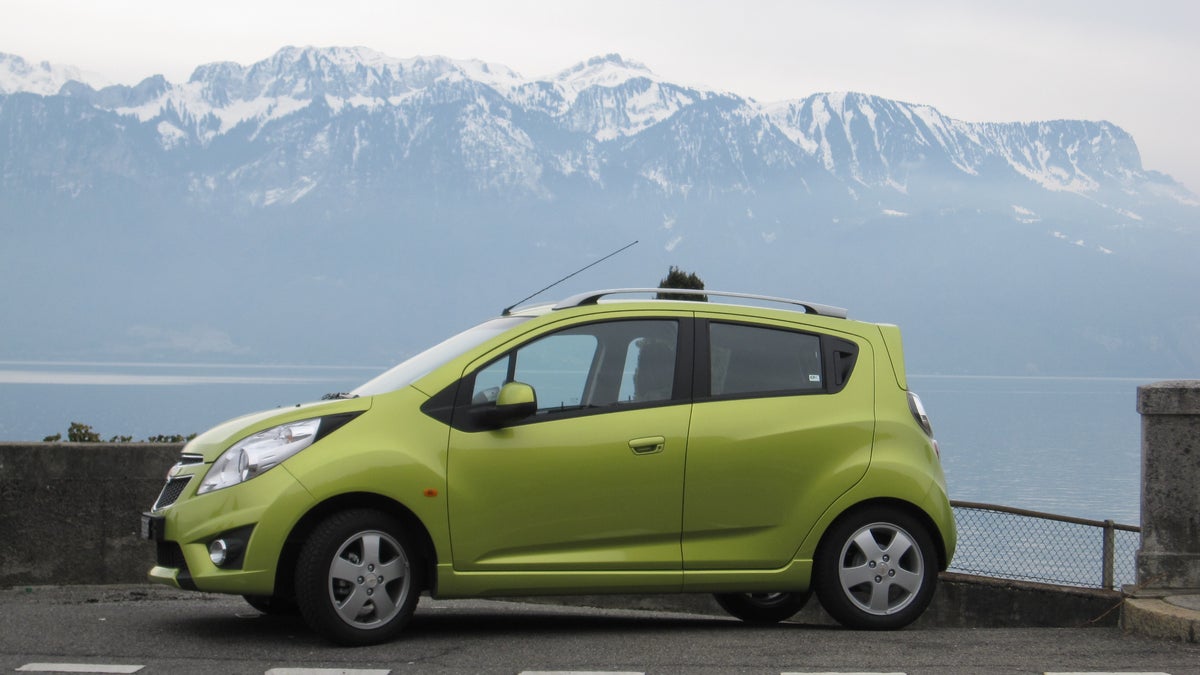Chevrolet hopes Spark lights a fire
CNET Car Tech gets a preview drive in a European spec Chevrolet Spark.

GENEVA--Formerly known for its big SUVs, GM now thinks small cars are a great idea and is planning three models that slot below the Malibu in its lineup over the next three years. The all-new Chevrolet Spark comes out in 2011, a redesigned Aveo in 2012, and the Cruze--replacing the current Cobalt--later this year. GM gave us a chance to drive the Chevrolet Spark in Switzerland after the Geneva auto show.
GM already launched the Spark in Europe last year, where it serves as an ambassador for the Chevrolet badge. Not many Europeans have experience driving Chevrolets, and the tiny Spark should create a positive impression, given European automotive predilections. We drove a European-spec Spark, which has a less powerful engine than what will be offered in the U.S.
The Spark is a funky-looking little car, with dimensions reminiscent of the Honda Fit. The headlight casings look over-sized and are set into the fenders of the snub-nosed front-end. The grille carries the now-standard cross-bar bearing the Chevrolet bow-tie and an aggressive-looking air scoop sits in the lower fascia.
With rear wheels pushed to the far back corners, the doors take up the sides of the vehicle, with hidden C-pillar door handles giving the Spark a futuristic look. Front side windows dip down into the fenders, accentuating a generally busy design. Given the small palette, the busyness of the design may be intentional to from the size of the car.
All of these style elements make the Spark stand out in a way that will probably be polarizing to Americans. As such, Chevrolet maintains modest projections for sales in the U.S. According to GM, it hopes that the Spark achieves cult popularity, similar to the Scion xB.
Despite its size, the Spark didn't feel cheap when we got into it. Sure, the dashboard and door panels were made of hard plastics, but Chevrolet used a fine, cross-hatched texture that looks much better than the pebbled surfaces of old. The glossy panel around the radio has a subtle carbon fiber design, and the steering column-mounted instrument cluster is comprised of a traditional speedometer and digital display.
Although a hatchback, the Spark doesn't have the clever design of the Honda Fit, where rear seats can be folded out of the way to reveal deep cargo space. The Spark is more traditional than that. Chevrolet sells the car as a five-seater in Europe, but the U.S. version will have bulkier sides for better collision protection, limiting rear seat space to two passengers.
We had been told the Spark we would drive had a USB port, so we immediately whipped out an iPod cable to listen to music and test the interface. But instead of a full-blown port for an iPod cable, the Spark merely had a Mini-USB port mounted near the stereo. A Chevrolet representative told us that a mini to full-size USB adapter was available from the dealers, and that the car did have full iPod integration.
Beyond being put out that we couldn't plug in an iPod, we found it bizarre that Chevrolet would use a Mini-USB port, even in Europe. It might save some small amount of space in the dashboard, but very few USB storage devices use a Mini-USB interface.
We hadn't brought along any discs for the MP3 compatible single CD player, but it ultimately didn't matter all that much as the audio system in the Spark is a meager affair, with only four speakers.
Driving the Spark out of Geneva, we marveled out its lack of power. Flooring it in third gear while trying to slip into a gap in traffic produced only a gentle sensation of moving forward. Shifting down to second was somewhat better, as the engine wound up to 5,000rpm, getting closer to its 81 horsepower peak output.
Our Spark LT had a 1.2-liter engine, which one of the Chevrolet representatives had assured us was the more powerful of the two available in the Spark and appropriate for climbing the Swiss Alps. European ideas of engine size are much different than ours--for them, a 2-liter is about right for a dragster.
Traveling at city traffic speeds, about 30 mph in Geneva, the little Spark's steering felt nicely responsive, ready to make quick lane changes as long as no acceleration was required. The suspension was also a good mix between firm and comfortable, although we also had to give props to the Swiss for well-maintained roads.
Out on the open road, a highway running alongside the massive Lake Geneva, the Spark felt good, with enough power to easily maintain the 50 mph (80 kph) speed limit on flat land. On roads like this, the Spark should achieve the higher end of its European Drive Cycle fuel economy of 60 mpg.
But after a nice lakeside cruise, enjoying the views of tall, snow-capped mountain peaks all-around, our route headed up toward the town of Gruyere. We merged onto the Swiss autobahn, where the speed limit went up to 75 mph (120 kph) and the ascent challenged the Spark's little engine.
Relegated to the slow lane by the Spark's lack of oomph, we chugged upward, barely hitting the speed limit. Lacking any power reserve, passing other cars was completely out of the question. So we did what Europeans must generally do, sat back and enjoyed the scenery.
The Spark will undergo some changes before it launches in the U.S. next year. Most importantly, it should get a turbocharged 1.4-liter engine, giving it something closer to the kind of power Americans expect. The Mini-USB port may also be changed out for a full-size port, although adapter cables are easy enough to come by. And Chevrolet should also equip it with OnStar.
The Spark will be ready for the U.S., but will we be ready for it?

